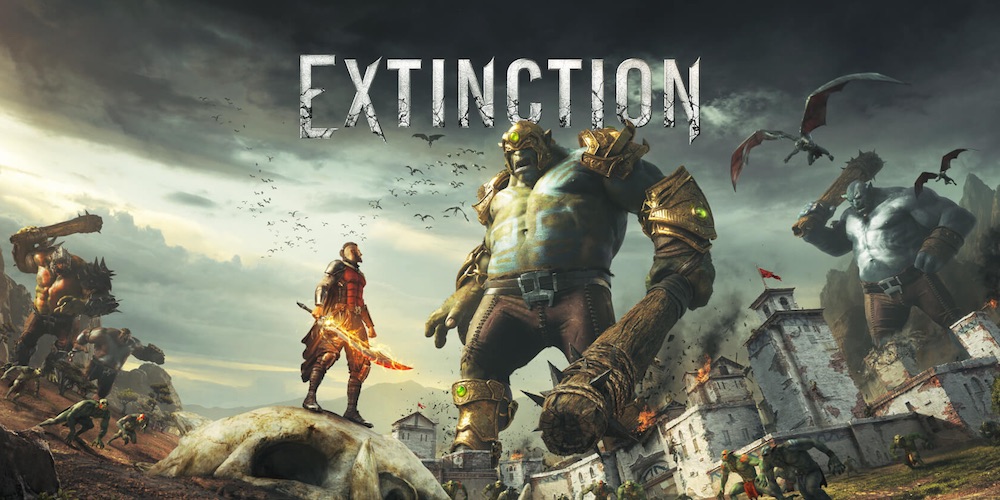
Full disclosure, Extinction is the kind of game that makes me want to write snarky, despicable things about it. After the last two weeks, however, I’ve read some reminders about the chronically unfair and unhealthy strain game development has on the people who make them. And it isn’t just massive AAA projects that demand unreasonable chunks of people’s lives; mid-level and indie projects suck the life out of developers often with lasting effects on their physical health and their families. I’m saying this to humble myself and to try and be nice, but I just…can’t. Extinction is the worst game I’ve played in a long time, and it makes me sad to say that. Iron Galaxy, the creators of Extinction, had a hand in the development of many of my favourite games, even so far as creating what I consider the best single-player campaign in a fighting game with Killer Instinct’s Shadow Lords mode. This game, though, makes me want to find a place for myself on the Darwin Awards list.
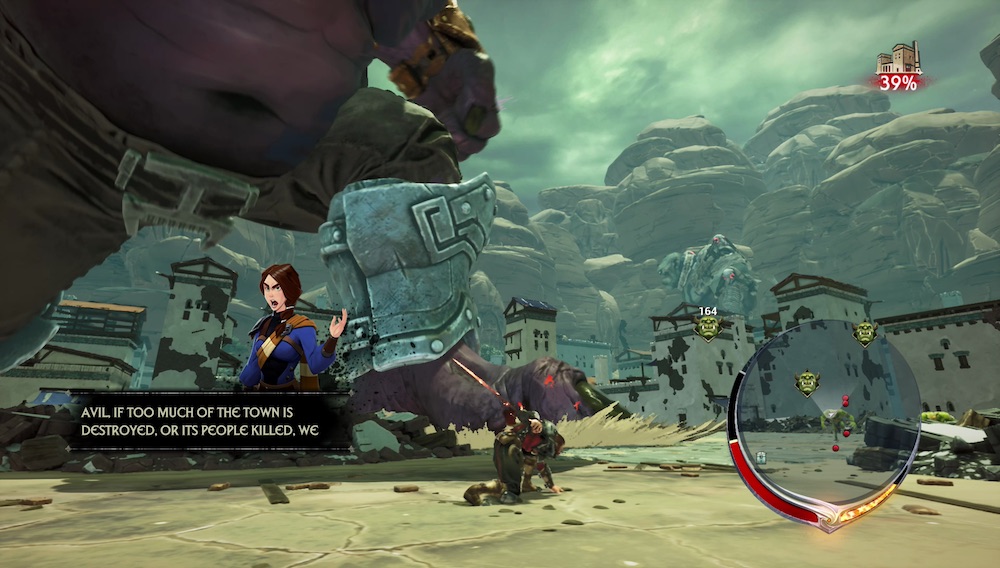
I could waste a paragraph telling you about the lore and setting of Extinction, but basically, it’s bilge – Attack on Titan by way of anemic Tolkienesque trappings with primitive greenskins, and the player is a hyper-acrobatic ranger. That premise, while wholly derivative and uninspired isn’t a terrible place to start for an action game. Plenty of good stories are told in entirely familiar ways with rote elements – but Extinction gaffes every aspect of world building and storytelling in genuinely affronting ways. The world is introduced to us in a limply animated short upon taking on the first mission but takes the liberty of assuming we should give a toss about our-soon-to-be-grating protagonists by merely inferring their relationship and then making a massive time-jump and expecting us to be on board. Extinction then quickly throws players into gameplay after this baffling intro that confuses mystery intrigue with vagueness and presumptuousness, and at the time I believed that to be a relief. It might be rubbish, but at least it was self-aware enough to not get in the way of the gameplay. Alas, my rejoice came too soon as I then spent the next 5 minutes with the game paused to hear the clumsiest mixture of exposition and tutoring I’ve had since the nineties.
Amidst my errant day-dreaming, I managed to glean some of the basics about Extinction: Players control Aviil, a ninja/ranger/monkish-warrior pastiche with a wankerly hairdo and an annoying companion who insists on interrupting gameplay every thirty seconds, generally after spatterings of dialogue that only get in the way of learning how to play the game. For the first ten minutes of the opening level, I scrambled gibbously about trying to figure a handle on the controls, which were only partially explained. I spent most of that time between being caught in a loop bouncing off of treetops and conversely halted by tree-stumps. All this was happening in-between having the gameplay paused abruptly to wade through more swathes of pointless banter. After ten minutes of trying to figure out if there was anything to be gleaned from this twerp’s incessant yammering, I decided that the answer was no; there was nothing I couldn’t grasp myself from looking at the box art. There are giant bloody orcs destroying cities, and you take control of captain douchenozzle in an effort to save the world, so I just skipped all the dialogue from there on out.
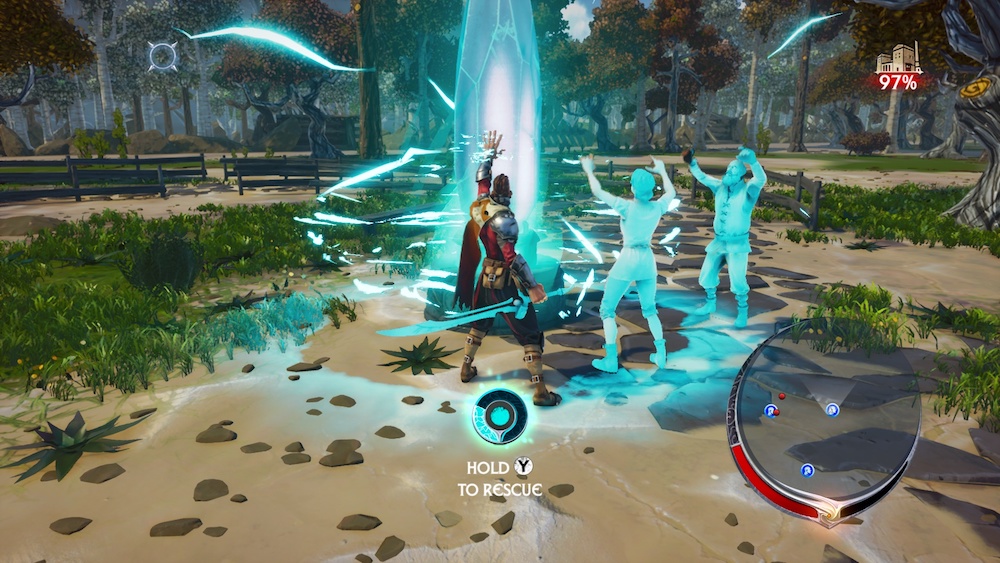
Gameplay then, once you’ve ventured through the bog of bilge-driven narration, should be a relief. Buuut it ain’t. Instead, it intensifies the whole experience into a shitstorm of dissatisfaction. The central spanner in the works of what is Extinction is the camera. As a third-person melee-combat game that scales between fighting 3-foot tall goblins on the ground and 200-foot giants at a fast pace, the camera system needs to compensate and accommodate for the player’s actions in a lot of intelligent ways. The camera in Extinction is less clever, and more suffering from some form of stroke. And piles. Traversing along the ground will pull the camera so far down as to only give you a decent view of every blade of grass in the entire bloody kingdom instead of where you’d care to move. Attempting to adjust the camera with the right stick is negated by default,so every time you move the right thumbstick to get a view of something more than the dandelions the long-suffering peons that were the texture artists on this game had worked on for three weeks, the camera will reset to tell you “no, you’ll look at the damned grass, peasant.” Once the giant Ravenii show up on any level, things don’t improve – the camera will ALWAYS pan towards them, in spite of what you may be trying to do instead. By design, Extinction doesn’t trust the player to have control of the camera and rigidly attempts to force your view in a fumbled bid to hold your hand.
Furthering the theme of arbitrary obstruction by design is the combat gameplay loop. You see, you can’t just go straight after the giants, chopping off limbs and heads straight away, nooo. The player needs to charge Aviil’s “Killstrike” meter so he can perform attacks strong enough to affect the Ravenii. To charge up the meter, players need to kill goblins and rescue civilians. Both can be found hanging around giant blue crystals, which have been placed in any given level by your yammering sidekick by mode of, you guessed it, a contrived plot device. Crystals can be found both at ground level as well as on top of buildings, and your mini-map will tell you where crystals are, but not at what elevation. Combat with Goblins is shallow – button mashing is the strategy du jour. Occasionally the little green turds will attack you, and if you get hit more than twice, you’re dead. There is a dodge button for evading their attacks, but their animations are too quick and difficult to discern because of the constantly awkward camera. None of that matters much, though, because pressing the attack button as quickly as possible wins without fail. As boring as they are to fight, it’s understandable that they’re under-designed. Saving civilians and killing goblins are filler to get in the way of fighting the Ravenii.
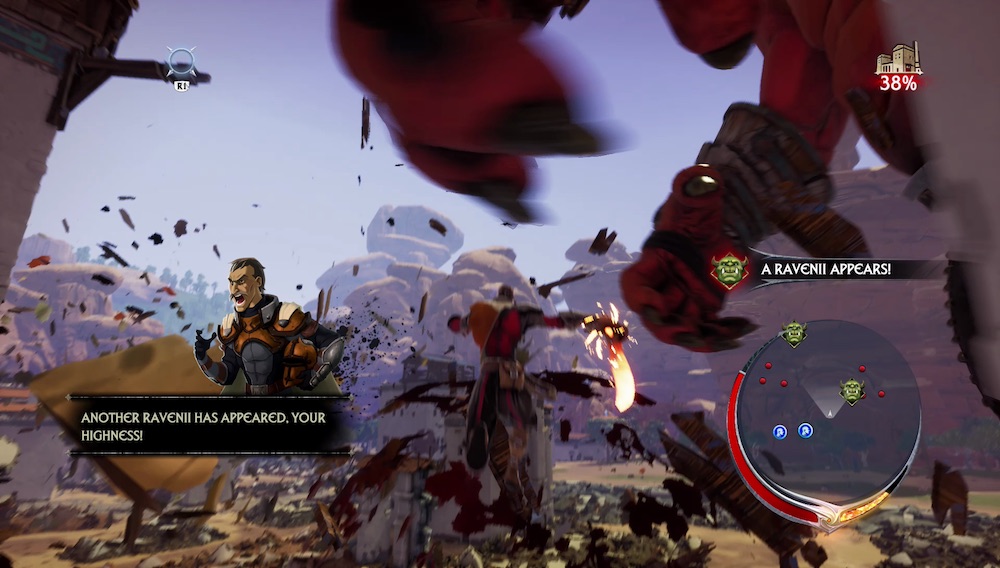
The Ravenii will plough through each settlement/city that serves as the current level, and overall health of the city is depleted, it’s game over. Each level has bonus objectives like rescue X number of civilians, or kill X number of cannon fodder, time trials etc., but the central loop of defending the city is an exercise in constant frustration due to the camera and controls. Admittedly, fighting the giant greenskins are more of a puzzle than their lowly counterparts, and in principle make for a fun sounding gameplay premise. It’s Shadow of the Colossus and a Spider-Man game mashed together, without any of the things that made those games fun. Aviil can move about like a superhero, scaling walls with ease, dash/glide forward through the air for short bursts, as well as a grapnel for reaching ledges and tree-tops. All of these traversal features sound pretty cool, but their functions are just that, functional, and don’t integrate well with all of the game’s components. While running up a city wall or tower is a straightforward act in spite of, yet again, the camera’s insistence of being too close at the worst of times, performing the same action on one of the Ravenii is face-plamingly cumbersome and irritating.
For such massive lumbering monstrosities, they move at a pace that puts a lot of pressure on the player’s ability to overcome the shallow traversal system and move over enormous spaces to catch up with the giant snot-towers. This movement speed also makes it an awkward pain to attack specific body-parts or pieces of armour that need to be hit in order to finish a Ravenii off with a decapitation. Sounds simple enough, but you guessed it, the camera and aiming controls do a better job of helping me inspect Aviil’s keester for rectal lumps than helping me cut down jade giants. On the note of getting cut down, the camera strikes again if you ever find yourself in front of a Ravenii. I died more than I care to remember from blows that came from beyond the reach of the spastic camera and Aviil’s intolerably slow air dash. Layer on top of this a progression system bereft of additional functions, but plenty of upgrades offering to let the payer do the same things, only faster, with a bigger pool of health. No. I will not wade through that in the hopes of having fun, thank you.
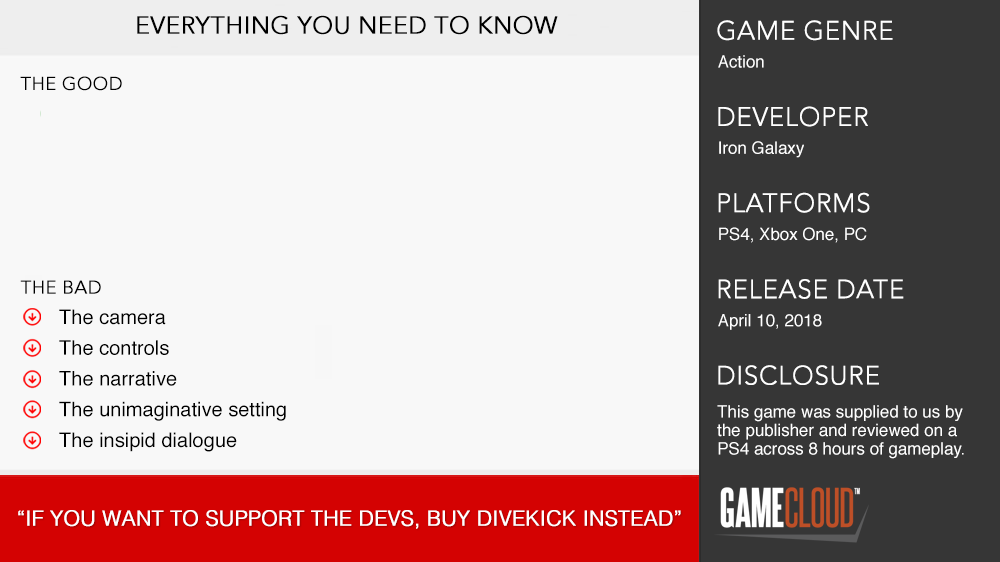
I’m sorry to anyone at Iron Galaxy who has to read this. I also hope that anyone who reads this knows that the video game industry is one that can indeed be tougher than any words I’ve used to voice my displeasure in playing Extinction. For a full-priced game, this is just impossible to recommend. Iron Galaxy has co-developed and ported many games, but it also made Divekick, and that game was plenty of fun. Buy that instead, for everyone’s sake.











